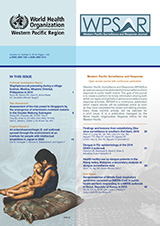An enterohaemorrhagic Escherichia coli outbreak spread through the environment at an institute for people with intellectual disabilities in Japan in 2005
DOI:
https://doi.org/10.5365/wpsar.2017.8.4.010Abstract
Objective: An enterohaemorrhagic Escherichia coli (EHEC) outbreak at an institute with multiple facilities for children and adults with intellectual disabilities was investigated to characterize the cases and identify risk factors for infection.
Methods: A case was defined as a resident, a staff member or a visitor at the institute from 16 May through 30 June 2005 testing positive for type 2 Vero toxin-producing EHEC O157:H7 (confirmed case) or exhibiting bloody diarrhoea for two or more days (probable case). We collected and analysed demographic, clinical, laboratory and individual behaviour data to identify possible risk factors for infection and infection routes.
Results: We recorded 58 confirmed cases, of which 13 were symptomatic. One probable case was also found. The median age of the patients was 37 years (range: 6–59 years). Thirty-six patients (61%) were male. Thirteen patients (93%) had diarrhoea and six (43%) had abdominal pain. Two developed haemolytic-uraemic syndrome but recovered. All the patients were treated with antibiotics and tested negative after treatment. Some residents had problems with personal hygiene. The residents of one of the facilities who cleaned a particular restroom had 18.0 times higher odds of being infected with EHEC (95% confidence interval: 4.0–102.4) than those who did not.
Discussion: The source of the outbreak could not be identified; however, the infection may have spread through environmental sources contaminated with EHEC. We recommend that institutional settings, particularly those that accommodate people with intellectual disabilities, clean restrooms as often as possible to reduce possible infection from contact with infected surfaces.
References
Riley LW, et al. Hemorrhagic colitis associated with a rare Escherichia coli serotype. N Engl J Med 1983;308: 681-5.
Bell BP, et al. A multistate outbreak of Escherichia coli O157:H7-associated bloody diarrhea and hemolytic uremic syndrome from hamburgers. The Washington experience. JAMA 1994; 272: 1349-1353.
Bruneau A et al. Outbreak of E. coli O157:H7 associated with bathing at a public beach in the Montréal-center region. Can Commun Dis Rep 2004; 30: 133-136.
Carter AO, et al. A severe outbreak of Escherichia Coli O157:H7-associated hemorrhagic colitis in a nursing home. N Engl J Med 1987; 317:1496-500.
Centers for Disease Control and Prevention, Outbreaks of Escherichia coli O157:H7 associated with petting zoos—North Carolina, Florida, and Arizona, 2004 and 2005. MMWR Morb Mortal Wkly Rep 2005; 54: 1277-1280.
Muto T, et al. Outbreaks of enterohemorrhagic Escherichia coli O157 infections among children with animal contact at a dairy farm in Yokohama City, Japan. Jpn J Infect Dis 2008, 61:161–162. pmid:18362413
Varma JK, et al. An outbreak of Escherichia coli O157 infection following exposure to a contaminated building. JAMA, 2003; 290:2709-2712.
Michino H, et. al. Massive outbreak of Escherichia coli O157:H7 infection in schoolchildren in Sakai City, Japan associated with consumption of white radish sprouts. Am J Epidemiol, 1999; 150: 787-96.
Terajima J, et al. High genomic diversity of enterohemorrhagic Escherichia coli isolates in Japan and its applicability for the detection of diffuse outbreak. Jpn J Infect Dis 2002, 55:19–22. pmid:11971157
Tuttle J, et al. Lessons from a large outbreak of Escherichia coli O157:H7 infections: insights into the infectious dose and method of widespread contamination of hamburger patties. Epidemiol Infect 1999;122: 185-192.

